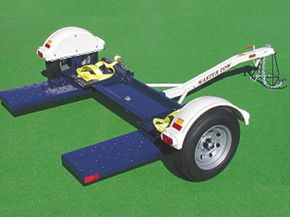Two Wheel Car Towing
Two-wheel car towing involves towing a car with its two front wheels off the ground. A tow dolly -- a short, two-wheeled trailer with ramps and slots your front tires drive up and nestle into -- attaches to the lead vehicle's trailer hitch. Rented tow dollies can offer a cheap and efficient way to get two cars from point A to point B. However, two-wheel towing has its disadvantages: The two tires riding on the ground will wear down more quickly than the two on the dolly, which can potentially cause poor handling when you drive the car later on. This isn't much of a consideration during a short or medium-distance one-way trip, but may cause problems if the car is towed often or travels over a very long distance.
If your car only has front-wheel drive, (where the power from the engine is delivered only to the front wheels) two wheel towing may be the best way to go. A car with front-wheel drive won't require any special steps: Only the two back tires are on the road, and since they're not connected to the drive shaft (which connects the axel to the transmission and engine), they'll just spin happily along the highway. Even better, since these wheels aren't connected to the engine, you won't register any miles on your towed car's odometer.
Advertisement
If your car has rear-wheel drive or all-wheel drive, there are some extra steps you'll have to take. First and foremost, you'll have to remove the drive shaft from your car. Normally, when you drive your car, your wheels are spinning because the drive shaft is delivering energy produced in the engine, distributed through the transmission and then to the drive shaft. But the process is reciprocal: If the engine is off, the spinning wheels -- for example, those of a rear-wheel drive car in tow -- will still put moving parts along the power train in motion. What's worse, oil and transmission fluid aren't being distributed, so the engine parts aren't lubricated and friction develops, which can cause severe damage to your car's engine.
With the drive shaft removed, the wheels are no longer connected to the engine; they're simply spinning along the axel. Drive shaft removal isn't necessarily a quick operation. For many people, this job is best left to a professional mechanic. This adds to the cost of to transporting a car -- on top of purchasing or renting a tow dolly. So why not simply back the car onto the tow dolly in the case of a rear-wheel drive car -- then it would be just like towing a front-wheel drive car, right? Wrong. Tow dolly rental companies and manufacturers explicitly warn against towing a rear-facing car with a tow dolly. This is due to the weight distribution found in most cars. Tow dollies are designed to accommodate most (if not all) of the car's weight. Since the bulk of a car's weight is found in front due to the weight of the engine, having that weight hanging off the back of a tow dolly can create an imbalanced weight distribution. At relatively low speeds, this improper weight distribution can cause the car in tow to whip -- a violent sway that can take both cars off the road.
For some people who tow often -- like RVers -- having to load and unload a car from a dolly to uninstall and reinstall the drive shaft is too much work. Many of these people look to tow bars instead. Read about this towing option on the next page.
